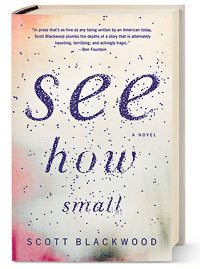It was a harrowing discovery that shocked the city of Austin, Texas—four bodies of teenage girls in the yogurt shop where they worked, burned beyond recognition. The ages of the victims—13, 15, and 17—coupled with the vicious nature of their deaths (they were gagged with their own underwear and shot in the head) made their murders particularly hard to fathom. Among those shaken by the crime was Scott Blackwood, then 26 and an English teacher at an Austin public high school for at-risk youth. “It hit me particularly hard because my daughter had been born three months before, and I was working with kids around the girls’ ages,” he says. “It stayed with me.”
More than 20 years later, Blackwood, now 49, a Chicago-based author of two respected works of fiction and a professor of creative writing at Southern Illinois University, has penned See How Small, an elliptical, poetic novel inspired in part by the still-unsolved murders. Changing perspectives of a rotating cast of characters—including the firefighter who finds the bodies, a mentally damaged Iraqi war veteran, and the victims themselves—weave in and out of the book in short, poignant chapters. With parts reminiscent of Jeffrey Eugenides’s The Virgin Suicides, See How Small captures the isolating nature of grief while avoiding the sensationalistic trappings often found in fictionalized accounts of real-life murders.
To write the book, Blackwood, who moved to Evanston from Austin in 2008 with his wife and youngest daughter, Ava, relied on his friend Jordan Smith, an Austin Chronicle reporter. “She told me how she had this green milk crate where she stored all the things she knew about the murders by her bed and how every once in a while, she would have these lucid dreams about aspects of the case.”
But the emotional insight required to complete the novel didn’t really hit Blackwood until Ava, then five, was reported missing from her Evanston daycare center in 2012. (She was later found at a friend’s house.) “The next day my wife and I were physically sore, like we had been carrying weights for two days,” says Blackwood, “and it occurred to me, imagine carrying this weight with you for the rest of your adult life. That’s like one one-thousandth of what [the victims’ parents] felt.”
Blackwood’s two previous works of fiction—a collection of short stories and a novel—garnered critical praise (he won the prestigious Whiting Award for 2010’s We Agreed to Meet Just Here), but neither generated the kind of early buzz See How Small has. It was the center of a bidding war between two powerhouse publishers, Harper Perennial and Little, Brown (Little, Brown snagged the book). But for Blackwood’s friend and fellow author Peter Orner, the attention comes as no surprise. “He’s taken an incredibly painful story that in other hands might be sensationalized, and not for a minute do you feel like he’s exploiting this tragedy.”
Blackwood also recently finished the second book of a two-volume set about the historic blues record company Paramount Records—a project that rocker Jack White commissioned him to write. (The first book scored Blackwood two Grammy nominations in December.) And he has plans for a prequel of sorts to See How Small, featuring the troubled war vet, Hollis. Turning minor characters into major ones in subsequent books is a tactic that Blackwood has used before. He credits Faulkner as his inspiration. “Why go away from the well,” Blackwood muses, “when it’s so deep and full?”




